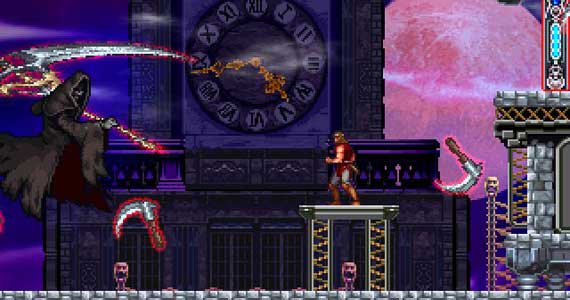
Spending time with Konami’s rebirth of Castlevania during the holidays has reminded me that new releases in the series don’t deserve an official seal of approval until I find myself confronted by a fairly simple objective, died multiple times trying to achieve said goal, and tossed the controller in anger.
Since this occurred several times last week, we’re good to revisit the Belmont clan and discuss all things short of my issues with gaming rage.
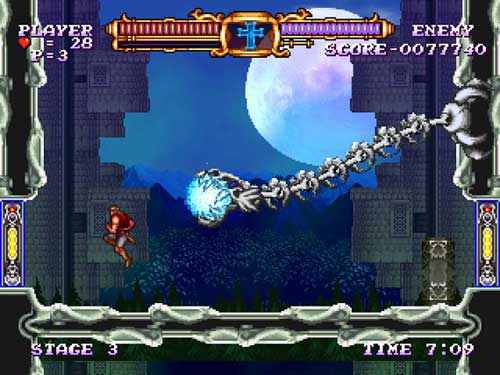
There’s old Castlevania, Symphony-Perfection-Castlevania, a metric tonne of handheld Metroidvania-Castlevania, 3D-trainwreck-Castlevania, and even a few entries in the WTF-Castlevania zone.
The Adventure ReBirth is reworked in the spirit of old level-style Castlevania that spawned it, for sale as nostalgia Castlevania, which makes it more of an resurgence or revisiting rather than the rebirth some of us wait hesitantly for, but the term rebirth works better for the marketing.
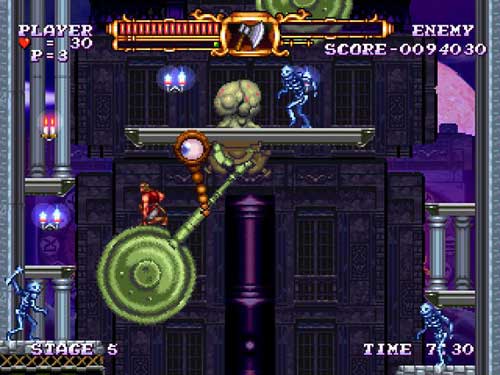
But enemies are put in places that enhance their difficulty, a bone throwing skeleton standing on a clock I’m trying not to hit comes to mind, and whoever decided clock towers should always be infested with flying Medusa heads can go at least halfway to hell knowing I still love them all the same. It’s all good, because enemy placement plays with the patience, waiting at the point where I might be tempted to rush forward.
Rushing forward is never a good idea, except when it is, an equation entirely owing to the dumbest strokes of luck that see me reach the other side of a stage without knowing entirely how I did it.
I suffer through all of it to get to the boss fights. Without taking away from the fact that Castlevania has always had the most varied and interesting stage enemies, the experience is completed by some of the most memorable boss fights in gaming.
My ideal of a Castlevania bossfight is a bit like a boxing match, taking a punch when you have to and generally playing defensively, jumping in to take the shot when the field is open, stealing an extra one whenever possible. Again there’s always that urge to rush in and mash the buttons, but this only reminds me how fast the life bar drops.
The life bar drops fast in ReBirth when you lose your patience.
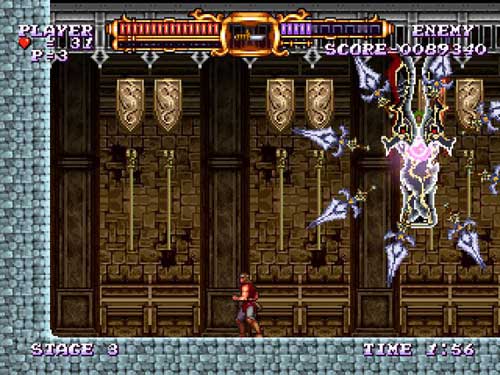
But that doesn’t mean the boss encounters within ReBirth don’t fit the game, they probably suit the stages quite well. The patterns work to the action established, but simply lack that sense of exhausted accomplishment I’ve come to cherish, which is certainly alive and well within the stages proper.
Stages also offer a few surprises along the way via variant pathways toward the goal, with secret stashes of points and beef to be found. One stage in particular revisits the classic puzzle scenario of multiple doors leading to multiple rooms, and around in circles a few times before decoding the ideal path.
As far as revisiting, beyond the nostalgia, there’s something to the way the levels build on each other, that gradual rising of difficulty and coordination until you find yourself in a clock tower cursing the people who decided Medusa heads should always be flying through clock towers – I just can’t let those go, ever.
I was worried the stiff movement might hold me back, but there’s a hell of a lot you can work with, using the axe to grab higher up items, and facing enemies that are paced in turn with your speed, and this has reminded me that the player doesn’t always need to bounce around like a superhero so long as the stages are up to the design challenge of being well designed.
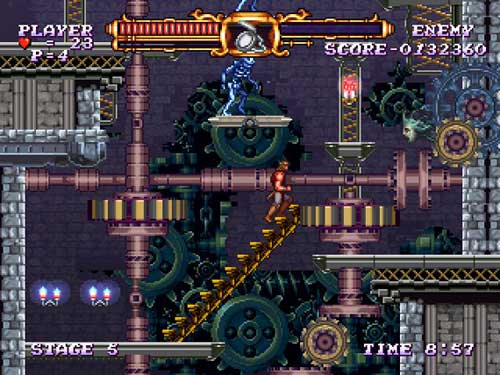
I wouldn’t say a strong personality quite emerges during the game. There’s no single stage I’m hung up on replaying again and again. There are a lot of great little sequences and moments, but this is a fairly standard crack of the whip through the castle. The game has some sympathy, usually leaving a chain power-up near a boss chamber incase you die, and that small kindness suits it well enough. The lingering, nagging thought as I play is that I miss leveling up, because the series changed so dramatically when I could be beaten down by enemies only to find them again later and return the favor with some new moves and weapons.
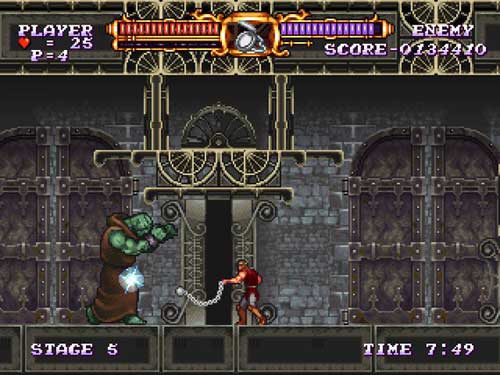
I don’t know that I can say which approach is best, because I’d rather focus on what I know I’ll replay. And while this release is competent and hits the visual and audio cues to deliver on the original experience, I’m less inclined to replay it like I have with so many other Castlevania titles.
Something changed when the series gifted us with the ability to build a sense of self within the world of Castlevania. It’s not ReBirth’s fault in anyway, but rather that Castlevania offers a world and characters with such potential depth, that the straightforward stage progression method fails to offer enough satisfaction and access to that world, regardless of the temporary charm nostalgia marks it with.
Take it all with a grain of salt since nostalgia is the name of the game I suppose. All I can ever do is give a summary of thoughts after the play-through. As a hellish romp it’s easy enough to say that ReBirth is worth a visit, but it’s also hard to continually subject myself to that design approach without a greater payoff.
Castlevania: The Adventure ReBirth
Developer – M2
Publisher – Konami
System – Nintendo Wii (WiiWare)
Release Date – December 28, 2009
*A copy of this title was purchased by Gamesugar for review
It’s basically a companion piece to Super Castlevania IV on VC… if one is to consider Rebirth as a prequel to it gameplay-wise. Still, for $10 you really can’t go wrong. Between this and Contra Rebirth, Konami is “reviving”, so to speak, their franchises in a good way. Hope the sales are there and we get more 2D games soon.
Comment by EdEN — January 5, 2010 @ 3:32 pm